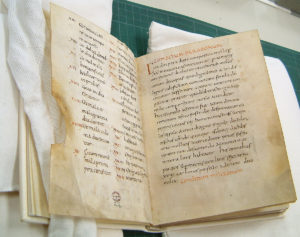
The New York Academy’s Manuscript of De Re Coquinaria
Romans, the world’s first recorded gourmets, today called buone forchette here in caput mundi, owe their obsession with food, at least in part, to fellow citizen Marcus Gabius. Better-known as “Apicius“, he was a wealthy and decadent epicure who in the first century wrote De Re Coquinaria (Concerning Culinary Matters), the world’s first cookbook. He specialized in spicy sauces and cakes and held extravagant feasts for his friends, in particular the Emperor Tiberius’ son, at his seaside villa at Minturniae between Naples and Rome. Alas, when he’d blown his fortune, Apicius poisoned himself, afraid to die of hunger. After his suicide, De Re Coquinaria was copied and recopied. The oldest two surviving manuscripts are in the Vatican Library and the New York Academy of Medicine.Thus leisurely dining has long been a favorite entertainment of the romani, so “when in Rome” take the advice of this “Roman by marriage” and enjoy some first-rate local dishes in the “grandeur that was Rome”.
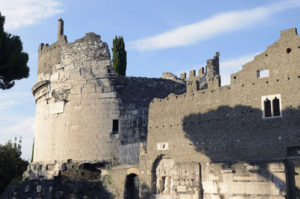
The tomb of Cecilia Metella
Hostaria Antica Roma/Running about 300 miles south to Brindisi and lined with cypress trees and umbrella pines, Via Appia begun in 312 B.C. is the oldest of Rome’s ten consular roads. It is here that the ancients led their torch-light processions to bury their dead. At No. 87 not far from the round Tomb of Cecilia Metella and across from St. Callixtus’ catacombs, is Hostaria Antica Roma, the second oldest restaurant in Rome. It’s also known as “Liberti” because it was originally a columbarium or tomb with niches for the urns of the Emperor Augustus’ 6,000 cremated freed slaves. There’s been a restaurant here 1796 when it was the first stop on the mail route to Naples.
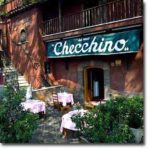
Checchino Da 1887
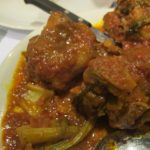
Coda alla vaccinara
Checchino dal 1887/ Although most of Rome’s bustling, clattery trattorie are family-run, only Checchino dal 1887 has belonged to the same family for so long–five generations of the Mariani family so far. The restaurant is carved into the man-made Monte de’ Cocci, a hill of an estimated 53,000,000 broken amphoras, dumped here, a short distance from a bend in the Tiber River and the Horrea Galbae or warehouses where the state-controlled reserve of olive oil was stored during the 2nd century AD. A sign of times to come, it would have cost more to repair them than to buy new ones.
Also thanks to its location, Checchino’s specializes in dishes using the quinto quarto-offal, tripe, intestine’s and oxtail-from the now-closed slaughterhouse across the street. In fact, coda alla vaccinara (oxtail braised with tomato and celery), now a classic of modern cucina romana, was invented here. Not everyone likes the thought of eating innards, of course, but if you want to dine authentically, this is the place. Be sure to tour the natural cantina-said to be Rome’s best. For the full story click on www.checchino-dal-1887.com.

Page from Aruk
Ristorante Spirito di Vino/ This beautiful medieval house with a loggia and arches once belonged to the Jewish Italian lexicographer and author of Aruk Nathan ben Jechiel (1035-1106), who began his sad life as a peddler of linens. He turned to scholarship and religion after four of his five sons died before adulthood. In actual fact, the house’s basement, now the cavernous wine cellar counting 800 labels, dates back to 80 BC. Trastevere was Rome’s first Jewish neighborhood and over the centuries the house has been a synagogue, a convent, a foundry, a private home, and a warehouse before being a restaurant.
Not to mention that before becoming a chef/owner Eliana Catalini, a devoted member of Slow Food, was a researcher and lab technician to Nobel Prize winner Rita Montalcini Levi. Catalini’s motto is “fresh KM 0 products and ancient recipes”. Her cult dishes include chickpea crepes with codfish sauce, veal meatballs with ginger, artichoke clafoutis, and basil-scented ratatouille.

Raphael’s fresco of “The Sybils”
Caffetteria del Chiostro/ Its large windows overlook Raphael’s fresco of “The Sibyls” housed in the Church of Santa Maria della Pace a short walk from Piazza Navona. Designed by Bramante (1444-1515), the cloister is the center of what originally was a monastery complex, which included the church. Open daily for breakfast, brunch, and lunch, its menu is rigorously “home-made”. In addition, the Caffetteria offers an interactive audio-visual guide of the Church and serves as a showroom for young artists who often set up temporary exhibits of their artworks here.
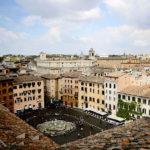
Terrazza Borromini

Velasquez’s Portrait of Innocent X
Terrazza Borromini/Near Bramante’s cloister, on the top floor of Palazzo Doria Pamphili, designed by the Renaissance architect Borromini and home to Pope Innocent X (reigned 1644-55), Terrazza Borromini offers breath-taking views of Piazza Navona. It’s a unique venue for an apertivo. Below on the first floor is the study center Centro Pro Unione. Established in 1969, this library’s collection of 22,500 volumes and 400 periodicals spans the disciplines of ecumenism and the theology of all Christian confessions as well as their history, liturgy, and spirituality. Library hours: Monday-Friday 9 AM-5 PM.

Cafe Colbert

Villa Medici
Caffè Colbert/ Started in 2016 by four young entrepreneurs on the roof of the 16th-century Villa Medici, the Caffè with a daily menu and honest prices overlooks the Villa’s magnificent gardens and the Spanish Steps. Once the Roman residence of the Florentine Medici family, the Villa Medici has been the French Academy for artists and scholars who win the Rome Prize since 1803. Among its famous borsisti or fellows were: Boucher, Subleyras, Fragonard, David, and Debussy. A musical evocation of its garden fountains features in Respighi’s Fontane di Roma. Besides the Caffè, the Villa’s gardens and temporary exhibitions are open to the public.
The French Academy, by far the oldest of all the many foreign academies in Rome, was established in 1666 By Louis XIV under the leadership of politician Jean-Baptiste Colbert, painter and art historian Charles Le Brun, and Gian Lorenzo Bernini. Before being transferred to the Villa Medici it was first housed in a modest building near the Church of Sant’Onofrio on the Janiculum, then moved to the Palazzo Caffarelli, now part of the Capitoline Museums, in 1683, to the Palazzo Capranica, now a cultural center, in 1684, and the Palazzo Mancini, now a bank, in 1725.
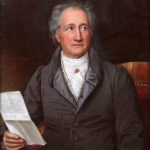
Goethe
La Campana/ Founded in 1518, this venue, Rome’s oldest restaurant, was first a winery and then an inn. Census records from 1526 show that a Pietro della Campana was the original owner, but its location on Vicolo della Campana (translated as “Bell Lane”) probably gave the restaurant its name (and possibly the owner his surname, too). Today this home-style trattoria near the Pantheon and Piazza Navona is run by siblings Paolo and Marina Trancassini, descendants of the family who’ve managed it for over a hundred years. Not surprisingly, La Campana is known for its authentic cucina romana. A favorite of Caravaggio, Picasso, Guttoso, Fellini, Anna Magnani, Pasolini, Maria Callas, and Alberto Sordi (celebrations for the 100th anniversary of his birh on June 15th, 1920 are now on hold because of coronavirus), and recently Emanuel Macron, to name only a few of its illustrious habituées, Goethe even wrote about the place, referring to it as “Osteria Campana” in the Römische Elegien (Roman Elegies). Must-try dishes include: tagliolini with anchovies and pecorino, puntarelle, artichokes both alla romana and alla giudia.

Pasolini and Maria Callas Photo credit: TriesteAllNews

Alberto Sordi in a scene from the movie “Americano a Roma”. (!954)
